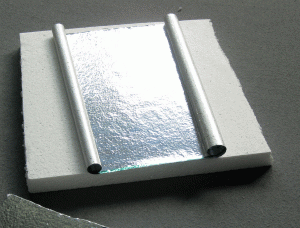
Reflective insulation is typically made of aluminum foil on a backing like rigid foam (pictured here), plastic film, polyethylene bubbles or cardboard.
Reflective insulation is a type of thermal insulation with at least one reflective surface that is installed so that the surface faces an air gap. It is usually made of an aluminum foil installed on a variety of backings, such as rigid foam, plastic film, polyethylene bubbles or cardboard.
CCHRC recently researched the use of reflective insulation in cold climate construction, reviewing other studies and testing two foam insulations with reflective facers. Researchers found that the use of reflective insulation has very little to offer cold climate construction.
To understand how it works, you need to understand the three types of heat transfer: convection is heat transfer through air movement; conduction is heat transfer through solid materials that are touching; and thermal radiation is when heat travels in electromagnetic waves, like energy from the sun.
Reflective insulations are designed to reduce heat transfer through radiation by placing a surface that reflects thermal radiation in combination with an air gap. The reflective surface reflects most of the thermal radiation toward the air space, preventing it from being absorbed by the material. If you don’t have an air space, then the heat is lost by conduction through the reflective surface. In real life, all these forms of heat transfer occur simultaneously. (Unless you travel to space to remove the atmosphere (air) from the equation. This partially explains why NASA took an interest in reflective insulations, as they faced very different conditions than we do in Alaska.)
In warmer climates, it is common to add reflective insulation in the attic to reduce heat transfer from the roof decking to the underlying insulation, reducing overall solar heat gain within a building. But in cold climates, we have different concerns. For example, homes lose heat primarily from air leaking through the attic and walls and conduction through all components of the house. Because most heat loss occurs this way, reflective insulation would not make much difference in reducing the overall heat loss of your home.
To illustrate this point, let’s examine part of a house where a reflective insulation system is added. If you created a 1-inch air gap into the wall or ceiling with a reflective surface on one side, you could expect to gain around R-2. But walls and ceilings are typically insulated in the range of R-20 to R-60, and reflective insulation faces sharp diminishing returns if multiple layers are installed. Also remember that the air gap needs to prevent airflow and the reflective surface needs to stay clean from dust and moisture.
In addition, many reflective insulations can increase the potential for moisture problems in your home if not placed properly, as they often act as strong vapor retarders. So if you’re using these products, you need to consider not just how they affect heat loss, but also moisture flow.
Watch out for claims about reflective insulations providing benefits that go beyond R-value. All of the product’s insulation value is captured by the R-value, just like fiberglass batts, foam board, and other insulation products. If there are additional benefits, such as reducing air leakage, then those benefits can be measured and compared to other air barrier systems.
In essence, reflective insulation may help in warmer climates but is not a great fit for a cold place like Alaska.